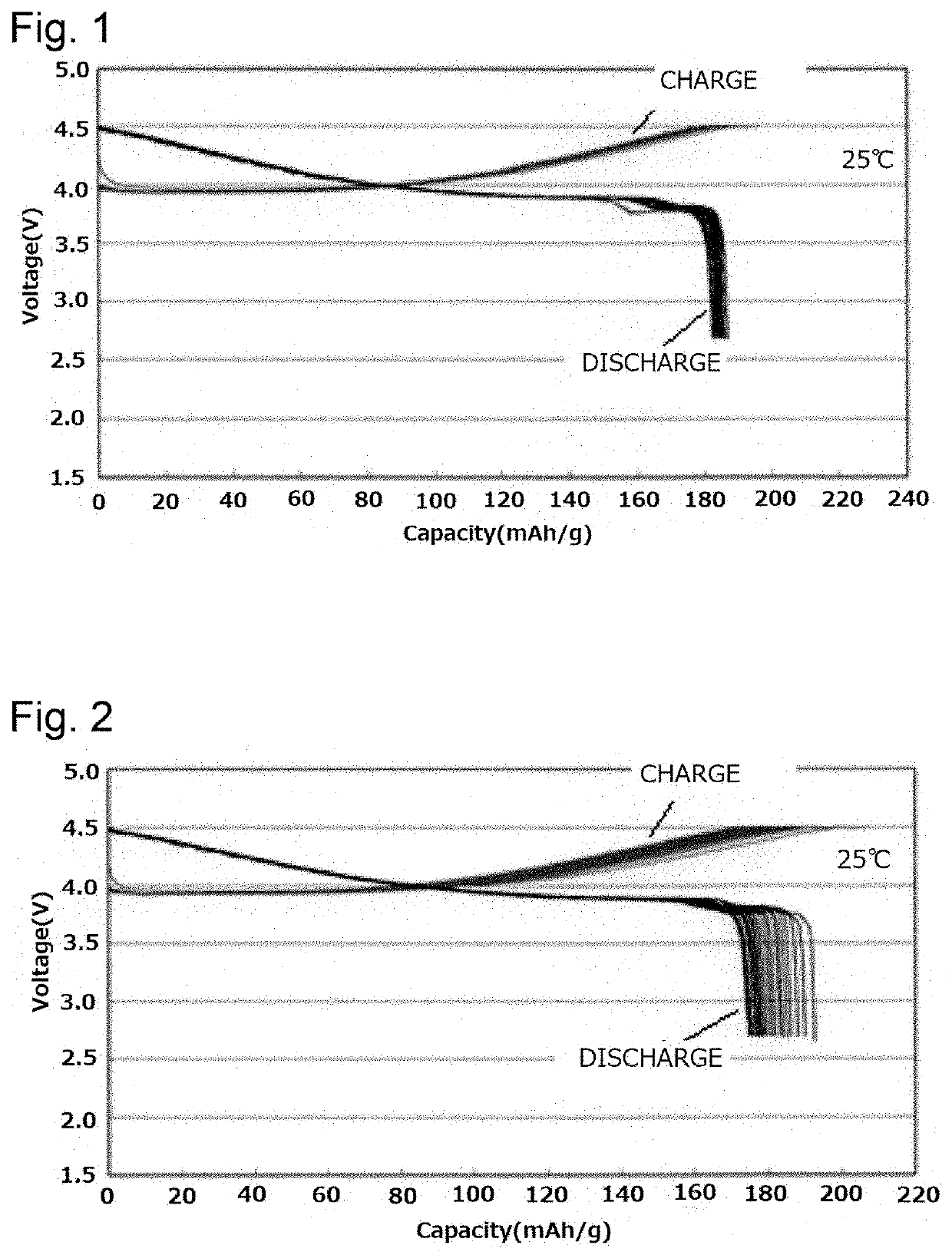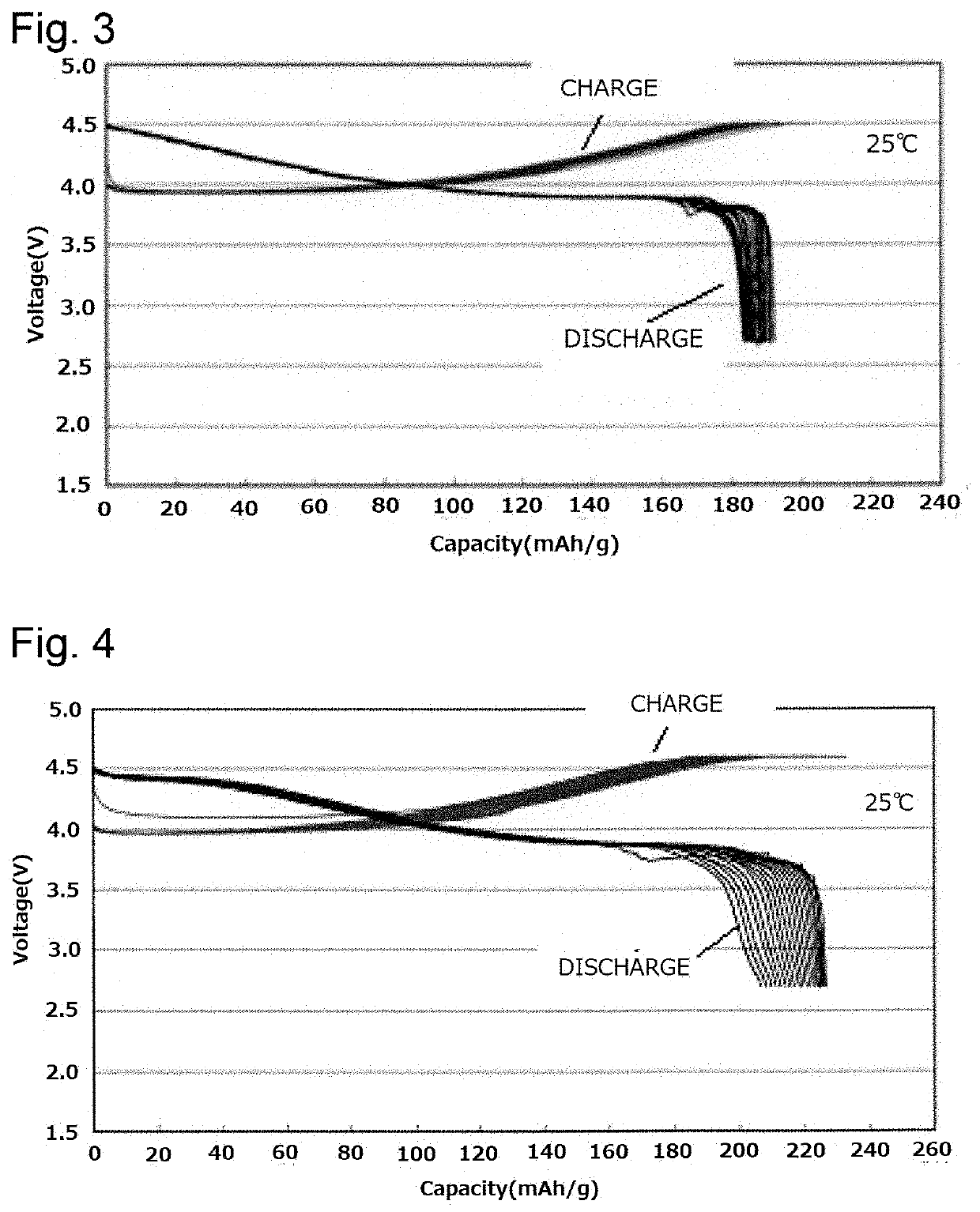Positive electrode active substance for lithium secondary battery and lithium secondary battery
a lithium secondary battery and active substance technology, applied in the direction of positive electrodes, cell components, electrochemical generators, etc., can solve the problems of lithium secondary batteries using lithium cobaltate and the achieve the effects of low energy density retention rate, and low deterioration of cycle characteristics
- Summary
- Abstract
- Description
- Claims
- Application Information
AI Technical Summary
Benefits of technology
Problems solved by technology
Method used
Image
Examples
example 1
[0162]30 g of the LCO sample 1 described in Table 1 was taken in a conical beaker; and 6 g of the magnesium sulfate-containing surface-treating liquid A-1 was added thereto and fully kneaded with a spatula or the like to thereby obtain a pasty mixture, which was then wholly dried by a drier at 100° C.; further, the obtained dry powder was subjected to heat treatment of firing at 800° C. for 5 hours to thereby obtain a magnesium sulfate-adhered LCO.
[0163]Then, the whole amount of the obtained magnesium sulfate-adhered LCO was transferred to a conical beaker; and 6 g of the lactic acid titanium chelate-containing surface-treating liquid B-1 was added thereto and fully kneaded with a spatula or the like to thereby obtain a pasty mixture, which was then wholly dried by a drier at 100° C.; further, the obtained dry powder was subjected to heat treatment of firing at 800° C. for 5 hours to thereby obtain a positive electrode active substance sample having an Mg-containing compound and a T...
example 2
[0168]There was obtained by the same operation as in Example 1, a positive electrode active substance sample having an Mg-containing compound and a Ti-containing compound adhered in amounts of magnesium and titanium adhered indicated in Table 3, except for that the LCO sample 2 described in Table 1 was used; A-2 as a magnesium sulfate-containing surface-treating liquid and B-2 as a lactic acid titanium chelate-containing surface-treating liquid were used; the sample 2 was brought into contact with the surface-treating liquids; and thereafter the resultant was wholly dried to obtain a dry powder, and the dry powder was subjected to heat treatment of firing at 1,000° C. for 5 hours.
[0169]Then, mapping of Ti atoms on the particle surface was carried out by SEM-EDX analysis of the obtained positive electrode active substance sample, and it was confirmed that Ti was present on part of the particle surface of the LCO sample 2.
example 3
[0192]30 g of the LCO sample 3 was taken and 0.125 g of magnesium oxide (MgO) and 0.061 g of titanium oxide (TiO2) were added thereto, and fully mixed by a laboratory mill; and the obtained mixed material was subjected to heat treatment of firing at 800° C. for 5 hours to thereby obtain a positive electrode active substance sample having magnesium oxide and titanium oxide adhered.
[0193]Then, mapping of Ti atoms on the particle surface was carried out by SEM-EDX analysis of the obtained positive electrode active substance sample, and it was confirmed that Ti was present on part of the particle surface of the LCO sample 3.
[0194]The magnesium oxide used was an aggregate composed of a secondary particle formed by aggregation of primary particles. Then, the average particle diameter of the aggregate as measured by a laser diffraction scattering method was 3.6 μm, and the average particle diameter of the primary particles as determined by a SEM photograph was 0.5 μm.
[0195]The titanium oxi...
PUM
| Property | Measurement | Unit |
|---|---|---|
| molar ratio | aaaaa | aaaaa |
| 2θ | aaaaa | aaaaa |
| molar ratio | aaaaa | aaaaa |
Abstract
Description
Claims
Application Information
 Login to View More
Login to View More - R&D
- Intellectual Property
- Life Sciences
- Materials
- Tech Scout
- Unparalleled Data Quality
- Higher Quality Content
- 60% Fewer Hallucinations
Browse by: Latest US Patents, China's latest patents, Technical Efficacy Thesaurus, Application Domain, Technology Topic, Popular Technical Reports.
© 2025 PatSnap. All rights reserved.Legal|Privacy policy|Modern Slavery Act Transparency Statement|Sitemap|About US| Contact US: help@patsnap.com



